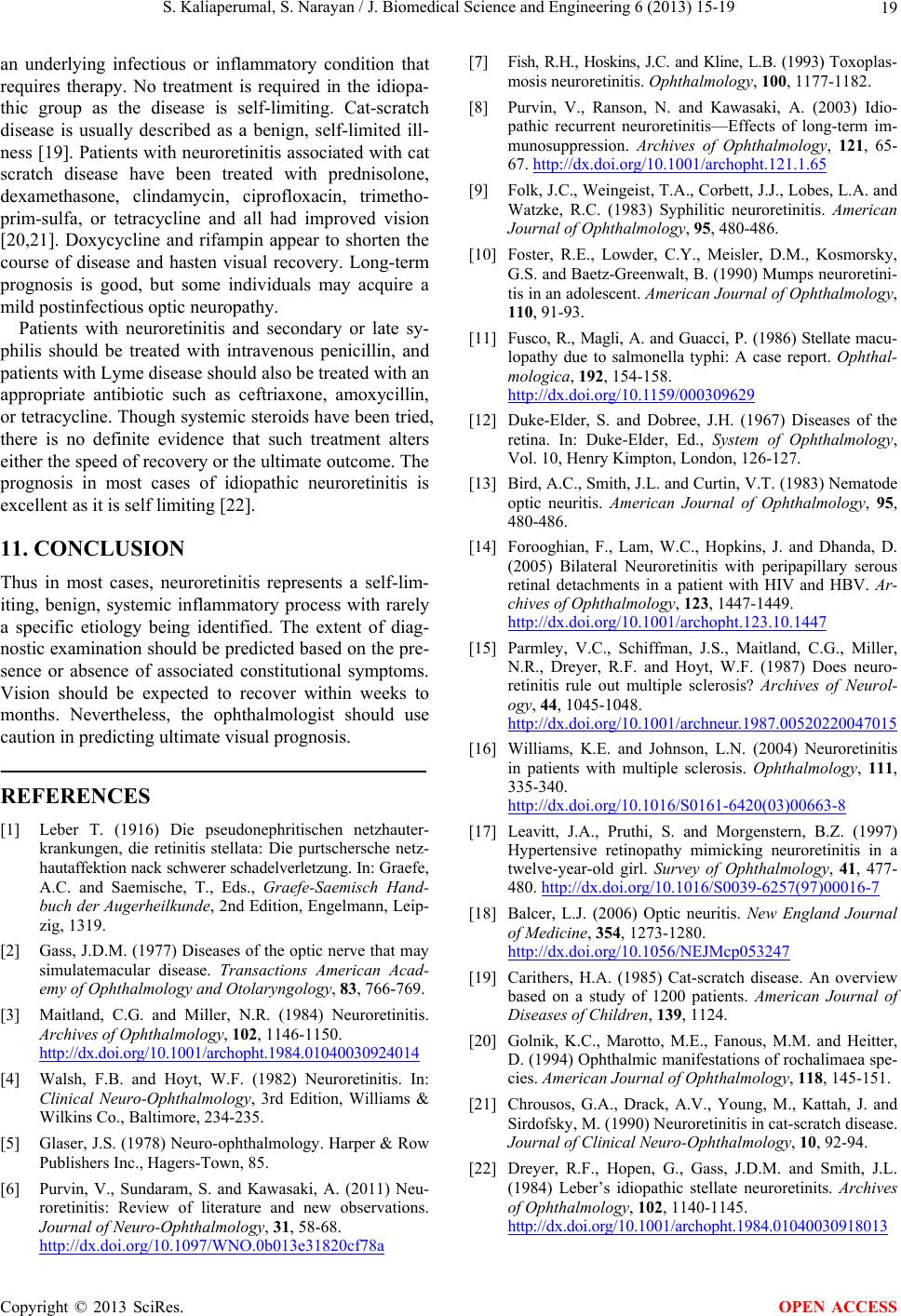
S. Kaliaperumal, S. Narayan / J. Biomedical Science and Engineering 6 (2013) 15-19 19
an underlying infectious or inflammatory condition that
requires therapy. No treatment is required in the idiopa-
thic group as the disease is self-limiting. Cat-scratch
disease is usually described as a benign, self-limited ill-
ness [19]. Patients with neuroretinitis associated with cat
scratch disease have been treated with prednisolone,
dexamethasone, clindamycin, ciprofloxacin, trimetho-
prim-sulfa, or tetracycline and all had improved vision
[20,21]. Doxycycline and rifampin appear to shorten the
course of disease and hasten visual recovery. Long-term
prognosis is good, but some individuals may acquire a
mild postinfectious optic neuropathy.
Patients with neuroretinitis and secondary or late sy-
philis should be treated with intravenous penicillin, and
patients with Lyme disease should also be treated with an
appropriate antibiotic such as ceftriaxone, amoxycillin,
or tetracycline. Though systemic steroids have been tried,
there is no definite evidence that such treatment alters
either the speed of recovery or the ultimate outco me. The
prognosis in most cases of idiopathic neuroretinitis is
excellent as it is self limiting [22].
11. CONCLUSION
Thus in most cases, neuroretinitis represents a self-lim-
iting, benign, systemic inflammatory process with rarely
a specific etiology being identified. The extent of diag-
nostic examination should be pred icted based on the p re-
sence or absence of associated constitutional symptoms.
Vision should be expected to recover within weeks to
months. Nevertheless, the ophthalmologist should use
caution in predicting ultimate v isual prognosis.
REFERENCES
[1] Leber T. (1916) Die pseudonephritischen netzhauter-
krankungen, die retinitis stellata: Die purtschersche netz-
hautaffektion nack schwerer scha delverletzung. In: Gr ae fe,
A.C. and Saemische, T., Eds., Graefe-Saemisch Hand-
buch der Augerheilkunde, 2nd Edition, Engelmann, Leip-
zig, 1319.
[2] Gass, J.D.M. (1977) Diseases of the optic nerve that may
simulatemacular disease. Transactions American Acad-
emy of Ophthalmology and Otolaryngology, 83, 766-769.
[3] Maitland, C.G. and Miller, N.R. (1984) Neuroretinitis.
Archives of Ophthalmology, 102, 1146-1150.
http://dx.doi.org/10.1001/archopht.1984.0104 00309240 14
[4] Walsh, F.B. and Hoyt, W.F. (1982) Neuroretinitis. In:
Clinical Neuro-Ophthalmology, 3rd Edition, Williams &
Wilkins Co., Baltimore, 234-235.
[5] Glaser, J.S. (1978) Neuro-ophthalmology. Harper & Row
Publishers Inc., Hagers-Town, 85.
[6] Purvin, V., Sundaram, S. and Kawasaki, A. (2011) Neu-
roretinitis: Review of literature and new observations.
Journal of Neuro-Ophthalmology, 31, 58-68.
http://dx.doi.org/10.1097/WNO.0b013e31820cf78a
[7] Fish, R.H., Hoskins, J.C. and Kline, L.B. (1993) Toxoplas-
mosis neuroretinitis. Ophthalmology, 100, 1177-1182.
[8] Purvin, V., Ranson, N. and Kawasaki, A. (2003) Idio-
pathic recurrent neuroretinitis—Effects of long-term im-
munosuppression. Archives of Ophthalmology, 121, 65-
67. http://dx.doi.org/10.1001/archopht.121.1.65
[9] Folk, J.C., Weingeist, T.A., Corbett, J.J., Lobes, L.A. and
Watzke, R.C. (1983) Syphilitic neuroretinitis. American
Journal of Ophthalmology, 95, 480-486.
[10] Foster, R.E., Lowder, C.Y., Meisler, D.M., Kosmorsky,
G.S. and Baetz-Greenwalt, B. (1990) Mumps neuroretini-
tis in an adolescent. American Journal of Ophthalmology,
110, 91-93.
[11] Fusco, R., Magli, A. and Guacci, P. (1986) Stellate macu -
lopathy due to salmonella typhi: A case report. Ophthal-
mologica, 192, 154-158.
http://dx.doi.org/10.1159/000309629
[12] Duke-Elder, S. and Dobree, J.H. (1967) Diseases of the
retina. In: Duke-Elder, Ed., System of Ophthalmology,
Vol. 10, Henry Kimpton, London, 126-127.
[13] Bird, A.C., Smith, J.L. and Curtin, V.T. (1983) Nematode
optic neuritis. American Journal of Ophthalmology, 95,
480-486.
[14] Forooghian, F., Lam, W.C., Hopkins, J. and Dhanda, D.
(2005) Bilateral Neuroretinitis with peripapillary serous
retinal detachments in a patient with HIV and HBV. Ar-
chives of Ophthalmology, 123, 1447-1449.
http://dx.doi.org/10.1001/archopht.123.10.1447
[15] Parmley, V.C., Schiffman, J.S., Maitland, C.G., Miller,
N.R., Dreyer, R.F. and Hoyt, W.F. (1987) Does neuro-
retinitis rule out multiple sclerosis? Archives of Neurol-
ogy, 44, 1045-1048.
http://dx.doi.org/10.1001/archneur.1987.00520220047015
[16] Williams, K.E. and Johnson, L.N. (2004) Neuroretinitis
in patients with multiple sclerosis. Ophthalmology, 111,
335-340.
http://dx.doi.org/10.1016/S0161-6420(03)00663-8
[17] Leavitt, J.A., Pruthi, S. and Morgenstern, B.Z. (1997)
Hypertensive retinopathy mimicking neuroretinitis in a
twelve-year-old girl. Survey of Ophthalmology, 41, 477-
480. http://dx.doi.org/10.1016/S0039-6257(97)00016-7
[18] Balcer, L.J. (2006) Optic neuritis. New England Journal
of Medicine, 354, 1273-1280.
http://dx.doi.org/10.1056/NEJMcp053247
[19] Carithers, H.A. (1985) Cat-scratch disease. An overview
based on a study of 1200 patients. American Journal of
Diseases of Children, 139, 1124.
[20] Golnik, K.C., Marotto, M.E., Fanous, M.M. and Heitter,
D. (1994) Ophthalmic manifestations of rochalimaea spe-
cies. American Journal of Ophthalmology, 118, 145-151.
[21] Chrousos, G.A., Drack, A.V., Young, M., Kattah, J. and
Sirdofsky, M. (1990) Neuroretinitis in cat-scratch disease.
Journal of Clinical Neuro-Ophthalmology, 10, 92-94.
[22] Dreyer, R.F., Hopen, G., Gass, J.D.M. and Smith, J.L.
(1984) Leber’s idiopathic stellate neuroretinits. Archives
of Ophthalmology, 102, 1140-1145.
http://dx.doi.org/10.1001/archopht.1984.0104 00309180 13
Copyright © 2013 SciRes. OPEN ACCESS